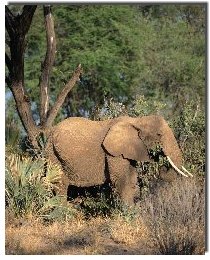
Elephants constitute the family Elephantidae in the mammalian order Proboscidea. Each of the two living genera has a single species: Loxodonta africana, the African elephant, and Elephas maximus, the Asian, or Indian, elephant. African elephants are the largest living land animals, although some forest-dwelling African elephants are small. The largest African elephants are 7.5 m (25 ft) long, including the trunk. They have a 1.4-m (4.5-ft) tail, stand 4 m (13 ft) tall at the shoulders, and weigh 7,500 kg (16,500 lb). The biggest Asian elephants are 6 m (20 ft) long with a 1.5-m (5-ft) tail, stand 3 m (10 ft) tall at the shoulders, and weigh 5,000 kg (11,000 lb).

African or Asian?
You can distinguish an African elephant from an Asian one by their larger size, bigger ears, and by their "swaybacked" look. If you get close enough, you can see that African elephants have two prehensile projections at the end of the trunk, while Asian elephants have one. These projections act like fingers and can pick up small objects like a twig, a leaf, or a flower. The well-muscled trunk can lift a tree. Heck... just as long as I'm not in it!
The most distinctive external feature of the elephant is the flexible, muscular trunk, or proboscis, an elongated nose with nostrils at the end as well as one (in the Asian elephant) or two (in the African elephant) fingerlike projections with which the elephant can examine, or even grasp, small objects. Elephants drink by sucking water into their trunks and then squirting it into their mouths. They have extremely large heads and short necks. Both sexes of the African elephant have tusks, which are greatly elongated incisor teeth, one on either side of the upper jaw. The largest known tusk weighed 107 kg (236 lb) and was 3.5 m (11.5 ft) long. Females have smaller tusks. Only male Asian elephants have tusks, and these are usually smaller than African tusks.
Elephants have fan-shaped ears that are up to 1.5 m (5 ft) long in the African genus, smaller in the Asian. The legs are massive and columnar and almost equally wide from top to bottom; the feet are broad and round. Both species have five toes on each forefoot, but the African elephant has three toes and the Asian elephant four toes (sometimes five) on each hind foot. The elephant's thick skin has sparse hair.
The African elephant is native to many parts of southern, central, and eastern Africa. It lives in forests, grasslands, river valleys, and deserts. Its numbers have been diminished by overhunting, mainly for the ivory of its tusks. Where it is protected, it tends to overpopulate and defoliate its range, resulting in starvation. The elephant uses its trunk to strip trees of branches and bark and even uproot them. A ban was placed on ivory trading in 1989 when the African elephant was declared endangered by the United Nation's Convention on International Trade in Endangered Species.
Asian elephants live in tropical grassy plains and rain forests. When the food supply is depleted, these elephants move in single file to more promising territory, which may turn out to be a cultivated plantation, putting the elephants in conflict with farmers. Because of continued encroachment by humans, the habitat of the Asian elephant is increasingly fragmented, affecting the health and stability of the population. This may soon put the Asian elephant at risk of becoming an endangered species. Asian elephants are often captured and domesticated for use as draft animals.
Elephants' bones lack marrow cavities; they are filled instead with a spongy material through which the marrow is distributed. Their grinding teeth are large and high, and usually only four teeth (excluding the tusks), one on each side of the upper and lower jaws, are present in the mouth at one time. Elephants eat only plant material, as much as 230 kg (500 lb) per day. One or two young are born after a gestation period of about 21 or 22 months.
Everett Sentman
Bibliography: Bosman, C., Elephants of Africa (1989); Chadwick, Douglas H., The Fate of the Elephant (1992; repr. 1994); Douglas-Hamilton, Oria and Iain, Battle for the Elephants (1992); Moss, Cynthia and Colbeck, M., Echo of the Elephants (1993); Sukamar, R., The Asian Elephant (1993).
The call of the African Elephant (elephant.wav) - 254KB
 |
 |
